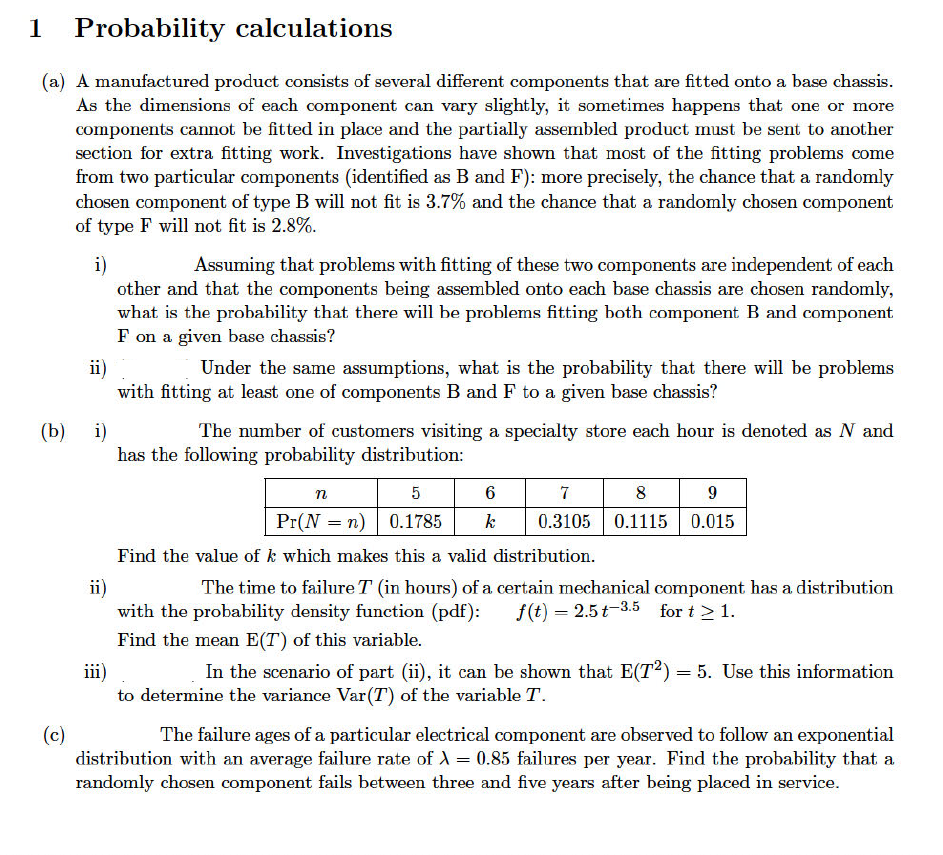1 Probability calculations (a) A manufactured product consists of several different components that are fitted onto a base chassis. As the dimensions of each component can vary slightly, it sometimes happens that one or more components cannot be fitted in place and the partially assembled product must be sent to another section for extra fitting work. Investigations have shown that most of the fitting problems come from two particular components (identified as B and F): more precisely, the chance that a randomly chosen component of type B will not fit is 3.7% and the chance that a randomly chosen component of type F will not fit is 2.8%. i) Assuming that problems with fitting of these two components are independent of each other and that the components being assembled onto each base chassis are chosen randomly, what is the probability that there will be problems fitting both component. B and component.
1 Probability calculations (a) A manufactured product consists of several different components that are fitted onto a base chassis. As the dimensions of each component can vary slightly, it sometimes happens that one or more components cannot be fitted in place and the partially assembled product must be sent to another section for extra fitting work. Investigations have shown that most of the fitting problems come from two particular components (identified as B and F): more precisely, the chance that a randomly chosen component of type B will not fit is 3.7% and the chance that a randomly chosen component of type F will not fit is 2.8%. i) Assuming that problems with fitting of these two components are independent of each other and that the components being assembled onto each base chassis are chosen randomly, what is the probability that there will be problems fitting both component. B and component.
College Algebra
7th Edition
ISBN:9781305115545
Author:James Stewart, Lothar Redlin, Saleem Watson
Publisher:James Stewart, Lothar Redlin, Saleem Watson
Chapter9: Counting And Probability
Section9.2: Probability
Problem 61E: Balls in a Jar Jar A contains three red balls and four white balls. Jar B contains five red balls...
Related questions
Question

Transcribed Image Text:1 Probability calculations
(a) A manufactured product consists of several different components that are fitted onto a base chassis.
As the dimensions of each component can vary slightly, it sometimes happens that one or more
components cannot be fitted in place and the partially assembled product must be sent to another
section for extra fitting work. Investigations have shown that most of the fitting problems come
from two particular components (identified as B and F): more precisely, the chance that a randomly
chosen component of type B will not fit is 3.7% and the chance that a randomly chosen component
of type F will not fit is 2.8%.
i)
(b)
(c)
Assuming that problems with fitting of these two components are independent of each
other and that the components being assembled onto each base chassis are chosen randomly,
what is the probability that there will be problems fitting both component B and component
F on a given base chassis?
ii)
Under the same assumptions, what is the probability that there will be problems
with fitting at least one of components B and F to a given base chassis?
i)
The number of customers visiting a specialty store each hour is denoted as N and
has the following probability distribution:
n
5
6
7
8
9
Pr(N = n) 0.1785 k 0.3105 0.1115 0.015
Find the value of k which makes this a valid distribution.
ii)
The time to failure T (in hours) of a certain mechanical component has a distribution
with the probability density function (pdf): f(t) = 2.5 t-3.5 for t > 1.
Find the mean E(T) of this variable.
iii)
In the scenario of part (ii), it can be shown that E(T2) = 5. Use this information
to determine the variance Var (T) of the variable T.
The failure ages of a particular electrical component are observed to follow an exponential
distribution with an average failure rate of λ = 0.85 failures per year. Find the probability that a
randomly chosen component fails between three and five years after being placed in service.
Expert Solution
This question has been solved!
Explore an expertly crafted, step-by-step solution for a thorough understanding of key concepts.
Step by step
Solved in 4 steps

Recommended textbooks for you

College Algebra
Algebra
ISBN:
9781305115545
Author:
James Stewart, Lothar Redlin, Saleem Watson
Publisher:
Cengage Learning

Algebra & Trigonometry with Analytic Geometry
Algebra
ISBN:
9781133382119
Author:
Swokowski
Publisher:
Cengage

College Algebra
Algebra
ISBN:
9781305115545
Author:
James Stewart, Lothar Redlin, Saleem Watson
Publisher:
Cengage Learning

Algebra & Trigonometry with Analytic Geometry
Algebra
ISBN:
9781133382119
Author:
Swokowski
Publisher:
Cengage